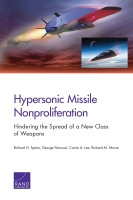by Richard H. Speier, George Nacouzi, Carrie Lee, Richard M. Moore
 What are the implications of the proliferation of hypersonic missiles to additional nations? That is, why should the United States and the rest of the world be concerned with such proliferation, and why should it be addressed now? What are the possible measures to hinder such proliferation? That is, is it feasible to hinder the spread of this technology, and who should buy into such an objective and with what measures? Which specific hypersonic technologies could be subject to export controls? What are the technical barriers to mastering hypersonic technologies? What are the economic barriers to mastering hypersonic technologies?
What are the implications of the proliferation of hypersonic missiles to additional nations? That is, why should the United States and the rest of the world be concerned with such proliferation, and why should it be addressed now? What are the possible measures to hinder such proliferation? That is, is it feasible to hinder the spread of this technology, and who should buy into such an objective and with what measures? Which specific hypersonic technologies could be subject to export controls? What are the technical barriers to mastering hypersonic technologies? What are the economic barriers to mastering hypersonic technologies?
Hypersonic missiles — specifically hypersonic glide vehicles and hypersonic cruise missiles — are a new class of threat because they are capable both of maneuvering and of flying faster than 5,000 kilometers per hour. These features enable such missiles to penetrate most missile defenses and to further compress the timelines for a response by a nation under attack.
Hypersonic missiles are being developed by the United States, Russia, and China. Their proliferation beyond these three could result in other powers setting their strategic forces on hair-trigger states of readiness. And such proliferation could enable other powers to more credibly threaten attacks on major powers.
The diffusion of hypersonic technology is under way in Europe, Japan, Australia, and India — with other nations beginning to explore such technology. Proliferation could cross multiple borders if hypersonic technology is offered on world markets.
There is probably less than a decade available to substantially hinder the potential proliferation of hypersonic missiles and associated technologies. To this end, the report recommends that (1) the United States, Russia, and China should agree not to export complete hypersonic missile systems or their major components and (2) the broader international community should establish controls on a wider range of hypersonic missile hardware and technology.
Key Findings
New Class of Threat
Hypersonic missiles are a new class of threat because they are capable both of maneuvering and of flying faster than 5,000 kilometers per hour, which would enable such missiles to penetrate most missile defenses and to further compress the timelines for response by a nation under attack.
The proliferation of such missiles beyond the United States, Russia, and China could result in other powers compressing their response timelines in ways that set their strategic forces on hair-trigger states of readiness — such as a strategy of "launch on warning." And such proliferation could enable such states to more credibly threaten attacks on major powers.
Time Is Key
There is probably less than a decade available to substantially hinder the potential proliferation of hypersonic missiles and associated technologies.
There appears to be interest in hypersonic missile nonproliferation and at least a few years available for relevant governments to put a policy in place.
International Concern
The unavoidable requirement is for the United States, Russia, and China to agree on a nonproliferation policy.
France could play a key role in bringing other governments into agreement on a broader control policy.
The technical and economic barriers to developing hypersonic technology are great enough to add to the effectiveness of a nonproliferation policy.
No comments:
Post a Comment